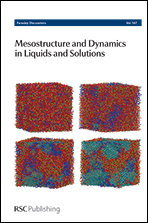Low-density liquid water is the mother of ice: on the relation between mesostructure, thermodynamics and ice crystallization in solutions
Abstract
Predicting the temperature and extent of ice freezing in aqueous solutions is crucial for areas as diverse as cryobiology and materials design. It has long been recognized that the thermodynamics of liquid water controls the temperature and kinetics of ice crystallization. Parameterizations of the freezing temperatures in terms of the water activity of the solution have been successfully established, but the fundamental origin of the thermodynamic control of the non-equilibrium crystallization of ice has remained elusive. Here we use large-scale molecular simulations to elucidate the relationship between the structure, thermodynamics, and ice crystallization temperatures for solutions of mW water and a strongly hydrophilic solute that mimics LiCl ions. Fast cooling of solutions with up to 20 mol% ions results in the formation of nanosegregated glasses with domains of low-density amorphous ice and an ion-rich vitrified solution. Slow cooling of the mixtures results in nucleation and growth of ice within the domains of four-coordinated liquid water. The temperature of crystallization TX coincides with the temperature of appearance of nanoscopic domains of four-coordinated liquid water in the mixture, TL. We use the insight provided by the simulations to derive a thermodynamic expression for the crystallization temperature as a function of the water activity, TX(aW), analogous to the dependence of the melting temperature, Tm(aW). The simple expression derived in this work provides a good account of the experimental freezing temperatures of water and the well-known steepest dependence of TX on solute concentration compared to that of Tm.
- This article is part of the themed collection: Mesostructure and Dynamics in Liquids and Solutions

 Please wait while we load your content...
Please wait while we load your content...